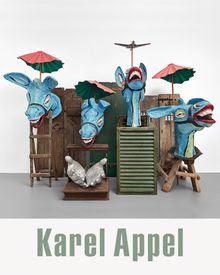ARTIST MONOGRAPHS
|
|
in stock $70.00 Free Shipping UPS GROUND IN THE CONTINENTAL U.S. |
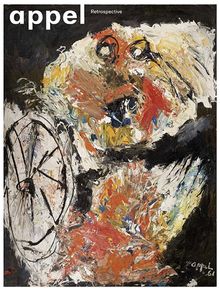 Karel Appel: Retrospective
Karel Appel: Retrospective
Published by Walther König, Köln.
Edited by Franz-W. Kaiser. Text by Klaus Ottmann, Rudi Fuchs. Interviews by Michel Ragon.
PUBLISHER
Walther König, Köln
BOOK FORMAT
Hardcover, 8.5 x 11 in. / 264 pgs / 145 color.
PUBLISHING STATUS
Pub Date 6/14/2016
Out of print
DISTRIBUTION
D.A.P. Exclusive
Catalog: FALL 2016 p. 99
PRODUCT DETAILS
ISBN 9783863358846 FLAT40
List Price: $50.00 CAD $67.50
AVAILABILITY
Not available
STATUS: Out of print | 00/00/00 For assistance locating a copy, please see our list of recommended out of print specialists |
Karel Appel: Retrospective 1945-2005
Published by Artimo/Meulensteen Art Museum.
Edited by Gerard Meulensteen, Vincent Polakovic and Gabrielle Wimmer. Essays by Rudi Fuchs, Lodovit Petrnsky and Florian Steininger.
PUBLISHER
Artimo/Meulensteen Art Museum
BOOK FORMAT
Hardcover, 9.5 x 12.75 in. / 144 pgs / 105 color / 15 bw.
PUBLISHING STATUS
Pub Date 3/1/2006
No longer our product
DISTRIBUTION
D.A.P. Exclusive
Catalog: SPRING 2006 p. 97
PRODUCT DETAILS
ISBN 9788089025176 TRADE
List Price: $60.00 CAD $70.00
AVAILABILITY
Not available
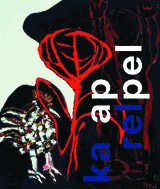 Karel Appel: Pastorale Chiaroscuro
Karel Appel: Pastorale Chiaroscuro
Published by nai010 publishers/Stedelijk Museum, Amsterdam.
Essays by Jean Fremon, Rudi Fuchs and Johannes Gachnang.
PUBLISHER
nai010 publishers/Stedelijk Museum, Amsterdam
BOOK FORMAT
Paperback, 12.25 x 9.5 in. / 144 pgs / 96 color / 48 bw.
PUBLISHING STATUS
Pub Date 7/2/2001
Out of print
DISTRIBUTION
D.A.P. Exclusive
Catalog: FALL 2001
PRODUCT DETAILS
ISBN 9789056622183 FLAT40
List Price: $35.00 CAD $47.50
AVAILABILITY
Not available
STATUS: Out of print | 00/00/00 For assistance locating a copy, please see our list of recommended out of print specialists |
 Karel Appel
Karel Appel
Published by Exhibitions International/Galerie Kusseneers.
Artwork by Karel Appel. Contributions by Rudi Fuchs, Rudi Fuchs.
PUBLISHER
Exhibitions International/Galerie Kusseneers
BOOK FORMAT
Hardcover, 9.5 x 12 in. / 114 pgs / 58 color
PUBLISHING STATUS
Pub Date 10/2/2000
Out of print
DISTRIBUTION
D.A.P. Exclusive
Catalog: FALL 2000
PRODUCT DETAILS
ISBN 9789076732022 TRADE
List Price: $29.95 CAD $35.00
AVAILABILITY
Not available
STATUS: Out of print | 4/24/2004 For assistance locating a copy, please see our list of recommended out of print specialists |
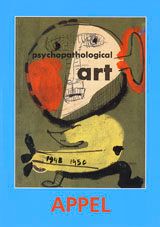 Karel Appel: Psychopathological Notebook
Karel Appel: Psychopathological Notebook
Drawings and Gouaches 1948-1950
Published by GACHNANG & SPRINGER.
Artwork by Karel Appel. Contributions by Rudi Fuchs. Text by Johannes Gachnang, Donald Kuspit.
PUBLISHER
GACHNANG & SPRINGER
BOOK FORMAT
Paperback, 9.75 x 13.5 in. / 200 pgs / 132 color.
PUBLISHING STATUS
Pub Date 1/2/2000
No longer our product
DISTRIBUTION
D.A.P. Exclusive
Catalog: FALL 1999
PRODUCT DETAILS
ISBN 9783906127576 TRADE
List Price: $65.00 CAD $75.00
AVAILABILITY
Not available
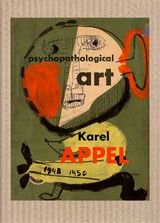 Karel Appel, Psychopathologisches Notizbuch
Karel Appel, Psychopathologisches Notizbuch
Zeichnungen und Gouachen 1948 - 1950
Published by Gachnang & Springer.
Artwork by Karel Appel. Text by Johannes Gachnang, Donald Kuspit.
PUBLISHER
Gachnang & Springer
BOOK FORMAT
Hardcover, 9.5 x 13.5 in. / 200 pgs / 132 color.
PUBLISHING STATUS
Pub Date 6/2/1998
No longer our product
DISTRIBUTION
D.A.P. Exclusive
Catalog: SPRING 1998
PRODUCT DETAILS
ISBN 9783906127521 TRADE
List Price: $120.00 CAD $145.00
AVAILABILITY
Not available
